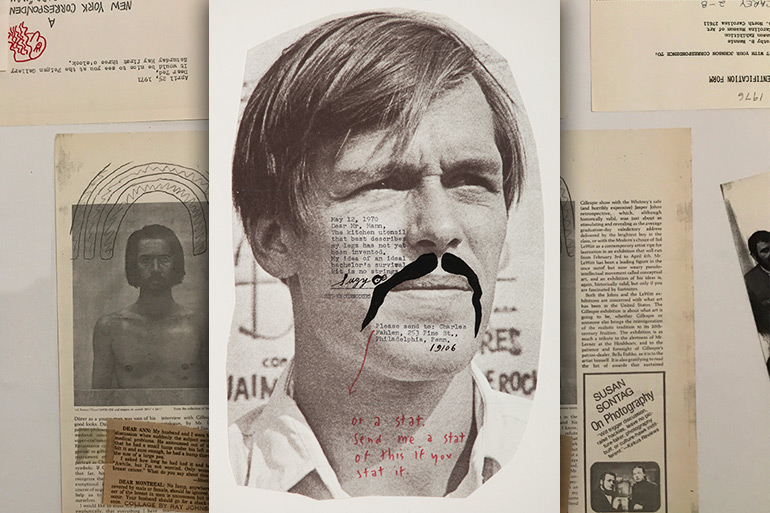Buried Treasure: Guild Hall Unearths Ray Johnson's Brilliance in Fall Show

Opening a letter from Ray Johnson would have been a perplexing yet magical experience for anyone lucky enough to receive one. The Locust Valley resident, who ended his life in Sag Harbor in 1995, is well known for his “mail art,” alive with scrawled missives, collage and drawings; all of it characterized by stream-of-consciousness musings, surreality and the absurd—all of it beautifully peculiar.
Two decades after Johnson sent his last letters and choreographed his early exit from the world by diving off the Sag Harbor-North Haven Bridge and backstroking out to sea in frigid January water, Guild Hall Associate Curator and Registrar of the Permanent Collection Jess Frost unearthed a nearly forgotten cache of the artist’s work. Carefully exploring what she found in the annals of the museum’s permanent collection, Frost sifted through this substantial trove of letters, collages and photographs, enjoying the sense of discovery and wonder.

Now, three years later, more than 30 pieces from Frost’s find are on view in Guild Hall’s fall exhibition, Please Send To: Ray Johnson, Selections from the Permanent Collection, open through December 16 in the Woodhouse Gallery. The work invites hours of examination as visitors look to decode each of Johnson’s creations as well as the connective threads that tie them together.
“It’s all of these cryptic, snake-eating-its-own-tail kind of things,” Frost says, detailing the time she’s spent obsessively poring over Johnson’s letters and compositions, establishing links layered upon links throughout.

A longtime admirer of Johnson, Frost took the job cataloguing Guild Hall’s permanent collection in 2015, and as she delved into the archive, she came upon a series of entries labeled only with numbers, 1–54, and limited information. “Eventually I found these manila folders in the flat files with tons of mail art,” Frost recalls.
After some digging, Frost learned the Johnson works were part of the museum’s Tito Spiga bequest, which included a large collection of art left to the museum upon Spiga’s death in 1988. “Tito donated a tremendous amount of art,” Frost explains, pointing out that one of Guild Hall’s galleries has since been named in his honor.

At the time of Spiga’s posthumous donation, Frost says there wasn’t much awareness about Johnson’s work, but his star has grown brighter in recent years, especially following the release of John W. Walter’s 2002 documentary about the artist, How to Draw a Bunny. The film about Johnson’s fascinating life and work—screening at Guild Hall on Sunday, November 26 at 4 p.m.—won a Special Jury Prize at the 2002 Sundance Film Festival and was nominated for an Independent Spirit Award that same year.
But at the time of Spiga’s bequest, “They must have been set aside, as they were never photographed or fully documented,” Frost says, adding, “No one had digital cameras,” so Guild Hall had no clear record of the work. She finally began photographing and cataloguing the individual pieces late last year.

“As soon as I found [Johnson’s work], I knew I wanted to do a show of it,” Frost says, noting that she began discussing the prospect with Guild Hall’s Chief Curator Christina Mossaides Strassfield right away.
Frost says that much of Guild Hall’s Johnson collection was addressed to painter Edward “Ted” Fawcett Carey, a former companion of Montauk Pop artist Andy Warhol, who eventually left the works to Spiga. “It just keeps unfolding,” Frost adds, describing her work tracking down names and references in the Johnson collection the way a historian might study important documents. “You can see these connections,” she says.
If one looks carefully, exhibition visitors will find all kinds of repeating themes, materials and interconnected content peppered throughout the works on view. Among many examples, simple elephant drawings labeled “Babar”—referring to French author Jean de Brunhoff’s series of children’s books—appear in multiple pieces of correspondence (two are illustrated in this article).

Another piece in Please Send To: Ray Johnson is titled “An Evening at Emak Bakia,” a framed collage featuring a sleeping baby (or starving African child?), which Frost has linked to other artists and correspondence. Basque for “leave me alone,” emak bakia is also the title of a Ted Carey painting and a 1926 sculpture and film by artist Man Ray. Frost also found a letter to Carey from Johnson referencing Emak Bakia as the name of their Oyster Pond Lane home in East Hampton. “This is just a little microcosmic example of the thread that goes through Johnson’s work and the permanent collection,” Frost says. “It totally appeals to the archivist in me.”
Another connection to Carey appears in a paper silhouette of the painter—something Johnson did with many friends and acquaintances—with the painter’s name written on it in Johnson’s hand. The silhouette, which still has folds from when Johnson mailed it, is framed with the original envelope, addressed to Pollock-Krasner House Director (since 1990) Helen Harrison—who was an instrumental part of the Spiga bequest.

Frost displays several of Johnson’s works framed on the wall, like Carey’s silhouette, while the bulk of them are left as is, lying flat in large vitrines. The curator says she only hung work that was already framed, while the major body of correspondence, writings and collage remain as they were intended and, thus, arranged in the vitrines. Framing the letters, Frost says, explaining the Johnson Estate’s wishes, would take the work out of context and show it differently than the artist intended.
A trained artist, Johnson landed on letters as his preferred medium, sending out his correspondence to a network of friends, acquaintances and even strangers, eventually spreading his web around the world and calling it the “New York Correspondence School.” Happy to claim the term “mail art,” Johnson acknowledged that others had done it before him, but none elevated the form to such a grand level.

“They read more like documents,” she says of Johnson’s ephemeral creations, full of wit, humor, crude jokes and, per Frost’s description, “trixter musings.” It’s also quite difficult to be sure exactly what Johnson did and what those who received his letters may have added—as he wanted them to do.
One of the pieces on view has a small drawing and “for Ted from Andy” written with a signature (see top left corner in image below) attributed to Warhol, which could be authentic or, just as easily, a gag perpetrated by Johnson. The artist often signed famous names to his letters, but the Pop art icon was his friend, so anything is possible.

In addition to the mail art and collage, Frost has put on display a series of six black and white photographs of Johnson, from a portfolio of eight, taken by his friends Joan Harrison and Michael E. Ach between 1980 and 1994 (see below). The pictures add a face to the enigmatic man behind this prolific body of work, which every local art lover must see.
Frost is giving a Gallery Talk about the show at Guild Hall on Sunday, December 2, from 12:30–1:30 p.m.
Please Send To: Ray Johnson, Selections from the Permanent Collection is on view at Guild Hall in East Hampton (158 Main Street) through December 16. For more info, call 631-324-0806 or visit guildhall.org.
Check out the Ray Johnson Estate website to take a deep dive into this artist and his work.




